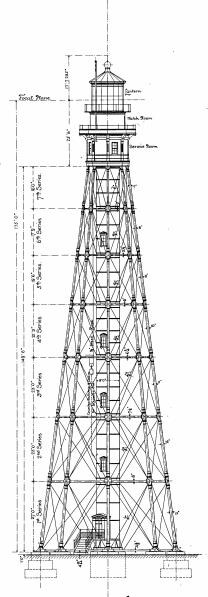Last updated: July 26, 2024
Article
Lighthouse Preservation

NPS
Few images are as evocative as a lighthouse on a rocky shore, guarding mariners and passengers as they navigate the currents, storms, and shifting shoals of America's coastal and inland waterways. Since the establishment of the first lighthouse in America at Boston Harbor in 1716, lighthouses have played a critical role in providing safe passage for all maritime activities. Although their form and appearance vary according to region or the body of water they guard, the lighthouse remains one of the most recognizable images of the maritime world. Yet like all historic structures, they require maintenance, care, and the attention of responsible, enthusiastic stewards. This is made even more essential due to the harsh conditions of marine or riverine environments where lighthouses stand.
In historic periods, the lighthouse keeper had the primary responsibility for care of the lighthouse. Today, the United States Coast Guard is the owner of most active lighthouses, or at least of the optic itself. Federal agencies such as the National Park Service may own or cooperatively manage lighthouses with the USCG, or private friends’ groups. For the many lighthouses decommissioned when they are no longer needed, any number of possibilities become options—but they all require care and attention.
The National Park Service administers various programs that may provide guidance or assistance to individuals or groups wishing to care for a lighthouse. Enacted in 2000, the National Historic Lighthouse Preservation Act (NHLPA) provides a mechanism for the disposal of Federally-owned historic light stations that have been declared excess to the needs of the responsible agency. The NHLPA allows them to be transferred at no cost to Federal agencies, State and local governments, nonprofit corporations, educational agencies, and community development organizations. These entities must agree to comply with conditions set forth in the NHLPA and be financially able to maintain the historic light station. The eligible entity to which the historic light station is conveyed must make the station available for education, park, recreation, cultural, or historic preservation purposes for the general public at reasonable times and under reasonable conditions. Lighthouses listed in or eligible for the National Register of Historic Places may be eligible for a state or federal historic rehabilitation tax credit; depending on certain conditions, some may also be eligible for various grant programs. Finally, the NPS National Maritime Heritage Program maintains inventories of historic light stations, educational resources, and links to preservation standards for those wishing to learn more, and when funding is available, provides grants for preservation of historic maritime properties. Contact the National Park Service for information about any of these programs.
Other funding or guidance for historic lighthouse preservation may be found elsewhere. The United States Coast Guard’s Historian's Office maintains documentation, photographs, official publications, oral histories, and other artifacts on the history of both the U.S. Lighthouse and Life-saving Service. The United States Lighthouse Society is a non-profit organization dedicated to historic lighthouses, with a large amount of resource material available to the public. States or local governments may also be sources of information. The state of Michigan—the state with the most lighthouses—makes information about its lighthouses easily available to the public. State Historic Preservation Offices, particularly in states with a large number of lighthouses, may also have information or resources to aid those interested in preserving historic lights.
